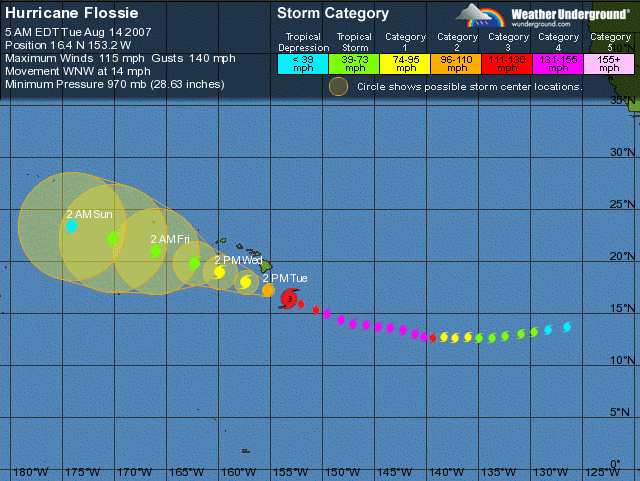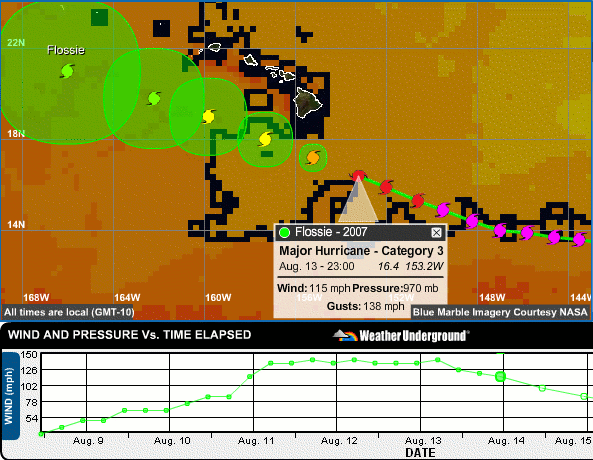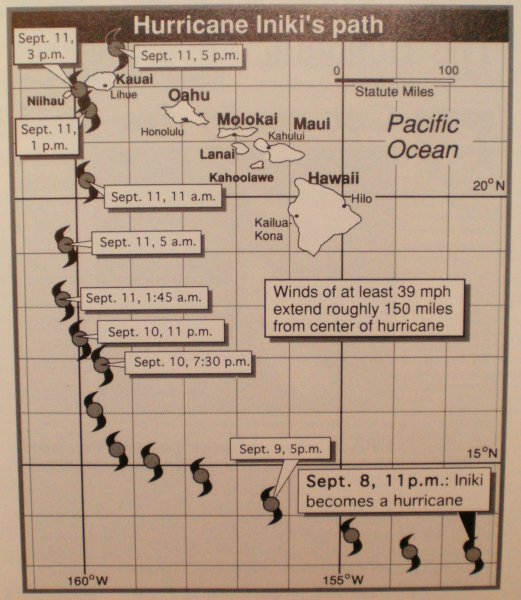Everyone on Kauai is anxiously hoping that hurricane Flossy will spare the island. Memories and stories of hurricane Iniki’s direct hit on Sept 11, 1992, are still vivid. Today, everyone says the weather is strange: there’s lots of wind and the dark clouds at all altitudes with sunshine in between. It just doesn’t feel like the usual patterns—no wonder animals can tell when storms are coming.
Update 12 hours later: the storm is down to category 2 and skirting the Big Island, where they have a hurricane watch, closing schools and opening shelters. The storm is about 65 miles (100 km) from the island, which is a fortunate distance because hurricane strength winds are felt about 40 miles ( 65 km) from the center. They are expecting 5-10 inches (12-25 cm) of rain and 25-foot (8-meter) waves. What they did not expect was the 5.3 magnitude earthquate last night. State Parks on the Big Island are closed, and hikers on other islands should probably avoid trails as the storm approaches.
For a while, Flossie was a category 4 hurricane (on the Saffir-Simpson hurricane scale) and the Hawaiian islands were within the range of predicted paths. Over the last twelve hours, the storm has weakened and is predicted to stay to the south of the islands, though it could brush close enough for Kauai to experience severe winds:

Source: wunderground.com
The NOAA has lots of real-time maps that track hurricane Flossie, but I found the ones at wundergound.com to be slightly more readable. Among them is the following, found under Flash Tracker, an interactive map that shows the sea surface temperature (SST):

Source: wunderground.com
I find it interesting because the hurricane is predicted to weaken now that it has entered cooler water. This seems to be the case on the map above, but what happens when it reenters the warmer waters south of Kauai? The story I’ve heard several times about hurricane Iniki (other than it broke the anemometer at a wind speed of 200 mph–320 km/h) is that it curved away from Kauai and then turned around and went straight towards the island. I found a track of hurricane Iniki that disproves the story, but it does show that the hurricane followed an easterly course across the Pacific, much like Flossie, before turning north to Kauai around the point where Flossie is right now:

Source: Hurricane Iniki, a “souvenir” book by the Honolulu Advertiser
But enough talk about the weather, what’s happening on the ground? Well, everyone is preparing for the possibility of the hurricane causing an emergency situation on the island. I’ve heard that emergency response centers have opened on all islands, and everyone is going shopping to replenish their hurricane supplies. The recommendation is to have food and water for up to a week, but after Iniki, some roads were blocked for weeks, and some areas had no water or electricity for months.
Every hurricane season, we have stocked a cupboard full of canned food, but we forgot to refill our 5-gallon (20 liter) water jugs this year. We also decided to buy boards to cover our largest windows, and we were not alone. Lots of pick-up trucks were leaving the Home Depot in Lihue with sheets of plywood, but they had not run out. They had reportedly run out of generators, so maybe the ones I saw were already sold. Plastic tarps are used for covering furniture indoors, in case windows or roof get blown out and let the rain in. I found some at Ace Hardware in Lihue, but they were almost out the useful sizes. However, Ace was out of water (the small bottles that are not environtmentally-friendly), and they needed to refill their 500 gallon (2 m3) tank of propane:


Like everyone else, I ended up at the Costco warehouse store to buy the other essentials in bulk. Looking at the shopping carts of local people who probably lived through hurricane Iniki, I estimate that the most important items are: bottled water (in those small, wasteful bottles again), bleach (to purify more water), and toilet paper. They hadn’t run out of these items, but they had already opened new pallets from their reserves. Actually, the stores seemed to be handling the supplies fairly well, perhaps they know what to stock during the hurricane season. And fortunately, I didn’t notice any price gouging.
Disaster shopping has a strange feeling. Everyone is buying a lot of stuff, everyone hopes their preparation and spending will be in vain, and yet everyone is cheerful and helpful even with the threat of a hurricane. One person was even optimistic enough to buy a new rug, though maybe it was on sale. The newspaper also has some good stories (here and here) about the preparations.
My predictions may be nothing more than amateur speculation, but something always feels like a significant phenomenon when you can see it from space:

Source: NASA via Reuters via yahoo.com
Andy,
I lived in Kaneohe on Oahu during Hurricane Iniki and I remember it well. Around 5:30 a.m. the warning sirens blared and woke us up. We had gone to bed unaware that it could be a problem for us, as it appeared to have resumed its westerly course. It “re-curved” (odd terminology) back to a northeasterly course overnight. My husband and I both worked in Honolulu and by 7 a.m. both places of employment and our son’s school were telephoning their cancellations. By 11 a.m. the TV was predicting that the eye of the storm would hit Honolulu and cross the Pali directly over Kaneohe. You can image how terrified we were. The mayor of Honolulu ordered the beach front hotels to evacuate to three blocks back with everyone required to go to the third floor, because they believed a 30-foot wall of water would hit the beach. As you can see from your chart on this page, the hurricane curved again and traveled directly to Kauai. I don’t know if the tourists actually left their hotels or not. Even as far away as we were, we saw pieces of tin roof fly past our hillside house during the strongest gusts. It was a memorable day, and we realized how fortunate we were as we read reports of the devastation on Kauai. I still watch the weather for the mid-Pacific during hurricane season and pray for all who live there.
Mary